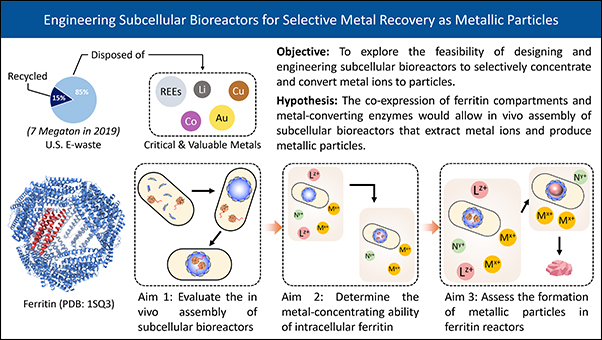The objective of this research is to explore the feasibility of designing and engineering subcellular bioreactors to selectively concentrate and convert metal ions to particles in support of circular economy strategies. The co-expression of ferritin compartments and metal-converting enzymes would allow in vivo assembly of subcellular bioreactors that extract metal ions and produce metallic particles.

Research Goals
Aim 1 is to evaluate the in vivo assembly of subcellular bioreactors.
Aim 2 is to determine the metal-concentrating ability of intracellular ferritin.
Aim 3 is to assess the formation of metallic particles in ferritin reactors.
Slide Text
- Engineering Subcellular Bioreactors for Selective Metal Recovery as Metallic Particles
-
Engineering Subcellular Bioreactors for Selective Metal Recovery as Metallic Particles
Pie chart illustrates 7 Megaton of U.S. E-waste in 2019: 15% recycled and 85% disposed of; an arrow points from the "Disposed of" segment to a box labeled "Critical & Valuable Metals" and the abbreviations REEs, Li, Cu, Co, Au in different colored circles.
Objective: To explore the feasibility of designing and engineering subcellular bioreactors to selectively concentrate and convert metal ions to particles.
Hypothesis: The co-expression of ferritin compartments and metal-converting enzymes would allow in vivo assembly of subcellular bioreactors that extract metal ions and produce metallic particles.
Representation of Ferritin (PDB:1SQ3)
Aim 1: Evaluate the in vivo assembly of subcellular bioreactors
Aim 2: Determine the metal-concentrating ability of intracellular ferritin
Aim 3: Assess the formation of metallic particles in ferritin reactors
